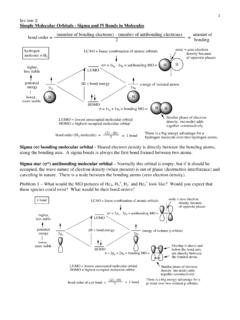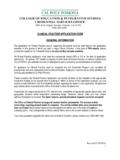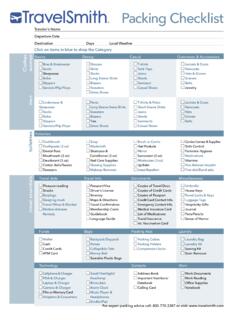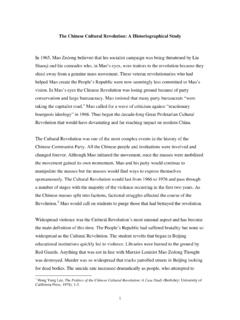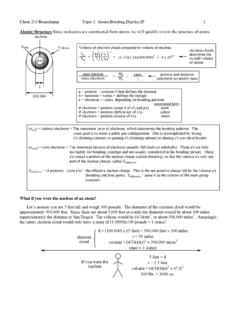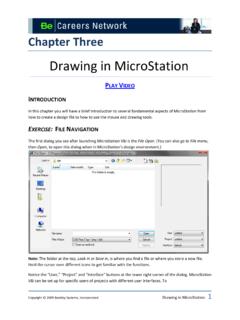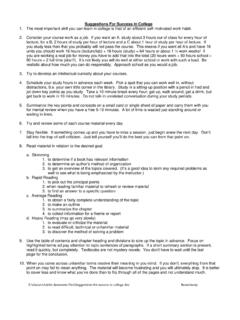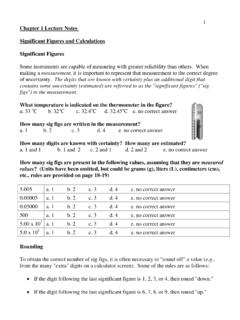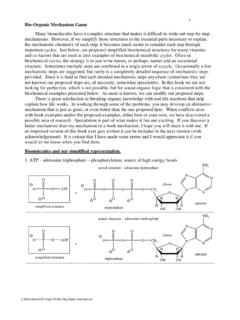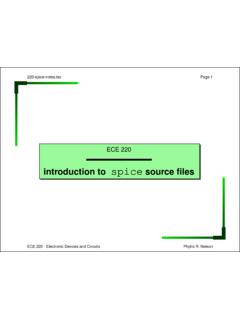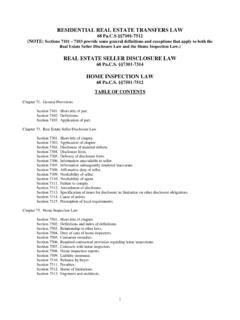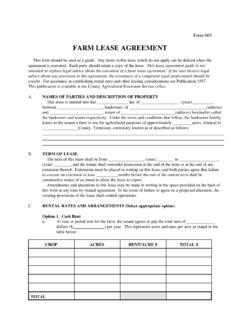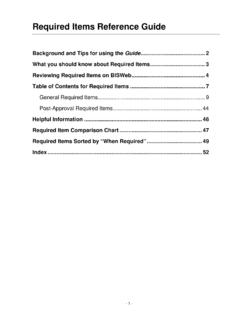Transcription of WRITING DESCRIPTIONS - CPP
1 WRITING DESCRIPTIONS Objectives when Describing Land A land description to be legally sufficient in the matter of locatability must identify a particular locatable area or areas to which the interest conveyed attaches. It is desirable that a land description: 1) Should contain title identity. 2) Should not interfere with the senior rights of others 3) Should be so written that either at the present or at a future date, a competent surveyor can readily locate it. 4) Should not contain words capable of alternate interpretations. 5) Should contain measurement data sufficient to describe a geometric area that closes mathematically. 6) Should be based on a recent survey. 1. Title Identity Title identity is the relationship between a particular description and its adjoiners. Certainty of location can be attained without certainty of title identity.
2 When composing a new conveyance the most desirable description from the title-guaranteeing agencies' viewpoint is one calling for adjoiners without reciting measurement information other than that necessary to complete a perimeter such as shown here: Beginning at the southwest corner of Thomas Brown's land as recorded in ..; thence along the southerly line of said Brown's land to the south-easterly corner thereof; thence in a straight line to the north-easterly corner of Doris Muller's land as recorded in ..; thence westerly along the northerly line of said Doris Muller's land to Third Street; thence along Third Street to the point of beginning. Bounded on the north by the land of Thomas Brown as recorded in ..; bounded on the west by Third Street; bounded on the south by the land of Doris Muller as recorded in.
3 ; bounded on the east by a straight line connecting the south-easterly corner of said Thomas Brown's land and the north-easterly corner of said Doris Muller's land. In this type of description exposure to damages resulting from discrepancies between monument locations and measurement data is eliminated; size is not stated. But such a description is or should be unsatisfactory to the new owner; it does not disclose on its face the quantity of land purchased. To be satisfactory to a new owner or to a surveyor, a description should be dimensionally complete. 2. Senior Rights Whether a conveyance interferes with the rights of an adjoiner or not does not necessarily alter the validity of the conveyance; but in instances, it may operate to make a conveyance partially void. If an author inadvertently included portions of an adjoiner's lands, the land inadvertently included is not conveyed, since a person cannot sell another's land.
4 Such inclusion does not operate to void the remainder of the conveyance, since the grantee can claim the land remaining after the overlap is excluded. Because a person may be held liable for selling land not his, it is desirable in composing DESCRIPTIONS to exclude lands of others. From a title insurer's point of view, it is a necessity that others' lands are excluded; the title insurer is liable for such inclusions, and by recent court opinions, in some states, the surveyor may also be liable. 3. Sufficiency of DESCRIPTIONS The purpose of a description is to identify a particular area, not to fully describe it; a description is sufficient if it identifies the land. What is legally sufficient and what is desirable are two entirely different things. Competent title authors strive to make a description complete within itself; that is, the description recites all senior claimants, describes all monuments, describes the size and shape by measurements, and agrees with existing possession on the ground (a fact that requires a recent survey).
5 The courts try to declare a conveyance valid rather than void. Only in cases where the area described by the writings is equally applicable to more than one location or where the deed fails to identify an area does the court reluctantly declare a deed void. How land may be described and what is sufficient are properly regulated by law, and, if the law prohibits a certain form of description, it may not be used. The right to refer to plats or maps (subdivision DESCRIPTIONS ), without including a perimeter description, is excluded in patenting federal mining claims and in describing certain political boundaries. In some areas building-site conveyances by metes and bounds DESCRIPTIONS are illegal. 4. Ambiguity English words often have multiple meanings and, if improperly selected, may cause ambiguity.
6 Words in one part of a description may conflict with words in another part. ambiguities or conflicts in general do not operate to void a conveyance; they merely require legal interpretation and sometimes court action to clarify the meaning of the description. Thus, in the event that "North" is written instead of "South," the deed is not necessarily void, since errors can be corrected if sufficient writings remain to identify the land. Competent scriveners eliminate conflicts or ambiguities from the writings. 5. Mathematical Correctness In many existing conveyances the area described is not mathematically correct and sometimes is not geometrically correct. This does not in itself invalidate a conveyance, since identity is all that is required. If a surveyor can locate the land described and measure and determine its area, the conveyance is sufficient.
7 When there is a call for monuments (including record monuments) it is almost impossible to assure mathematical and geometric closures without an accurate survey. Unfortunately, mathematical and dimensional completeness of a description is not a legal necessity; it is merely a desirable feature of a good description. 6. Description Based upon a Survey Unwritten conveyances or prolonged possession may transfer title to lands without writings. Possession is one of the many necessary elements of ownership. The purpose of a deed is to convey the ownership of land; without knowledge of a possession, relative to the described lines, certainty of transfer of ownership is not always possible. Occasions do arise wherein a description can be written without benefit of a survey, but it usually takes expert knowledge to determine when a survey is not necessary.
8 If a property is well monumented by definite monuments, it may be a simple matter to describe a rectangular parcel. Nowadays, especially in urban areas, the demand for title policies that guarantee both title and possession is greatly increasing the necessity for surveys. In many areas, new divisions of land are prohibited without surveys. Desirable Qualities of a Scrivener Competent scriveners should have knowledge of the following: 1. Trigonometry, geometry, and all elementary mathematics. 2. The legal meaning of all words and phrases used in land DESCRIPTIONS . 3. The location of known controlling monuments in the area of the description. 4. The science of measurements and calculations to prove the correctness of measurements. 5. Senior rights of adjoiners. 6. The order of importance of conflicting elements. Unfortunately, the activities of scriveners are seldom regulated by law many scriveners are incompetent to perform their duties.
9 Those better qualified are surveyors, title-company employees, abstractors, and attorneys. Attorneys specializing in title work are eminently qualified about the legal meaning of words and phrases used in land DESCRIPTIONS , and they know how to use proper conveyance forms. But they are often weak in mathematics, and the science and techniques of measurements and lack knowledge of possession on the ground. The skilled surveyor is eminently qualified in the techniques of measurements, mathematics, and monument locations and is usually qualified in the legal interpretation of words and phrases, but he is often weak in the knowledge of the right of adjoiners. In sectionalized land areas, the necessity of knowledge of seniority of conveyances is minimized. Better land DESCRIPTIONS can be made with the benefit of survey. Others occupying the area described may have occupancy rights, or monuments may be in positions other than that indicated by the record.
10 Technique of WRITING The art of WRITING DESCRIPTIONS is not simple; carelessly used words-or omission of words-can alter the entire meaning of a conveyance. Too many words may cause conflicting statements in a deed , whereas too few words may cause ambiguity and uncertainty. The best deed authors use a minimum of terms that give a clear intent without error, conflict, or ambiguity. The selection of the proper words to use comes from knowledge, experience, and practice. It is not the verbose writer filling many foolscap pages who wins acclaim in WRITING DESCRIPTIONS ; the writer who is applauded is the one who condenses but omits nothing essential, who creates no conflicts and is clear. Parts of a Description DESCRIPTIONS are divided into four parts: caption, body, qualifying clauses (including reservations), and augmenting clauses. Although in WRITING a particular description the four parts may be intermingled to make it difficult to distinguish one part from another, it is better practice, when feasible, to keep the four parts distinctly separated.
